|
| 2015 | JAN | FEB | MAR | APR | MAY | JUNE | JULY | AUG | SEP | OCT | NOV | DEC |
| 2016 | JAN | FEB | MAR | APR | MAY | JUNE | JULY | AUG | SEP | OCT | NOV | DEC |
| 2017 | JAN | FEB | MAR | APR | MAY | JUNE | JULY | AUG | SEP | OCT | NOV | DEC |
| 2018 | JAN | FEB | MAR | APR | MAY | JUNE | JULY | AUG | SEP | OCT | NOV | DEC |
| 2019 | JAN | FEB | MAR | APR | MAY | JUNE | JULY | AUG | SEP | OCT | NOV | DEC |
| 2020 | JAN | FEB | MAR | APR | MAY | JUNE | JULY | AUG | SEP | OCT | NOV | DEC |
| 2021 | JAN | FEB | MAR | APR | MAY | JUNE | JULY | AUG | SEP | OCT | NOV | DEC |
| 2022 | JAN | FEB | MAR | APR | MAY | JUNE | JULY | AUG | SEP | OCT | NOV | DEC |
| 2023 | JAN | FEB | MAR | APR | MAY | JUNE | JULY | AUG | SEP | OCT | NOV | DEC |
![]() Read current month's Daily Reflections
Read current month's Daily Reflections
![]() Table of Contents: Daily Reflections
Table of Contents: Daily Reflections
![]() Youtube Channel: Video Listing
Youtube Channel: Video Listing
June 2023
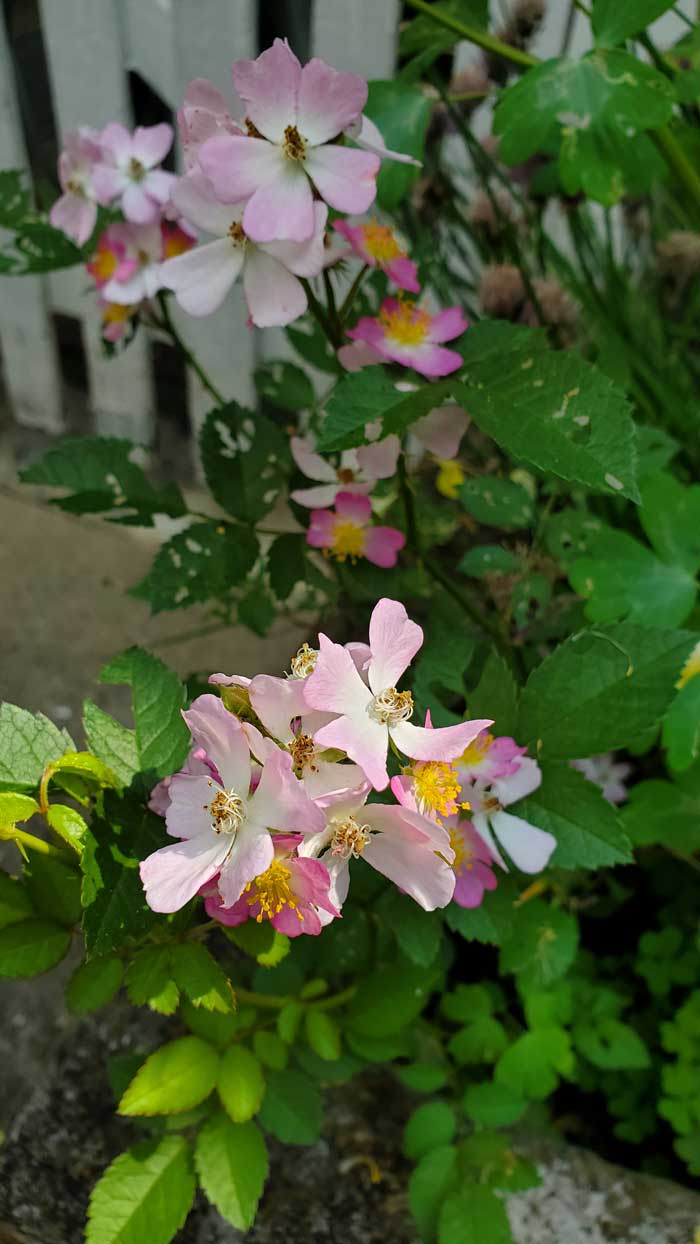
(Photo:Janet Kalisz)
Reflections June 2023
As a youngster, June was my favorite month, for this was the start of summer vacation and the true barefoot season. It was the busiest farm month with haying, setting and hoeing tobacco, gardening, tilling corn, picking fruit and berries, tending cows with calves, and many other things. June is the time of fresh produce: cucumbers, cabbage, potatoes, beets, blackcaps, and strawberries. In June the Kentucky sunshine is brightest, except when the thunder clouds roll in. Poppies, roses, peonies, scarlet sage, and black-eyed Susans help us pretend summer is enduring.
Roses |

Peony from an Appalachian memorial garden.
(*photo credit)
June 1, 2023 Overdosing with Fentanyl
America has always had some degree of chemical overdosing with either prescribed or legal materials, but it is emerging as an ever-greater problem in recent years, but especially since the start of the pandemic. In 1968 there were 5,073 deaths in this country; by 2019 the deaths had increased to 70,330 reported deaths along with unreported ones often hidden due to insurance collection purposes.
The major culprit in recent years has been the synthetic drug “fentanyl.” This is easily produced and 50 to 100 times more potent than traditional overdosing agents such as morphine. The combination of cheap cost and extreme potency makes this a killer of the first degree. Because of its abundance, some of the unscrupulous have inserted fentanyl into many other prescription and non-prescription overdosing agents; addicts and associates have not been notified; thus, many have become unintentional victims and thus thousands have died before any form of rescue has been attempted. Thus, fentanyl is the number one killer of 18–45-year-old Americans and may account for as many as forty thousand American deaths per year.
Overdosing is accompanied by lack of fear of drugs that ordinary citizens take. In fact, adults can have as many as five to ten different prescribed drugs per year and not even consider that the combination of some of these could cause much trouble. In fact, at the turn of the century most Americans were fearful of taking more drugs and told the medical professionals of their concerns. As the taking of chemicals became more relaxed, the opening to the possibility of overdosing increased to what it is today.
Respect the power of drugs. We must limit the intake of prescription drugs and consider that interaction is not always understood when two or more are present in the acidic stomach and other organs. Care must be taken both by the medical profession in issuing drugs and in the patients who must take them. It would be better if more attention were given to natural products used by primitive peoples over thousands of years. Many of the natural effects need to be reemphasized. Commercial medicines must be treated with utmost care, and every effort to remove fentanyl and similar products from circulation.
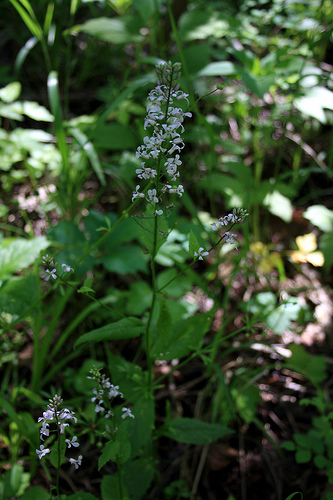
Native Kentucky mustard, purple rocket, Iodanthus pinnatifidus.
(*photo credit)
June 2, 2023 Observing National Go Barefoot Day
It is high time we have a day to celebrate bare feet. At the first of June we have that opportunity to enjoy what I loved in youth, and that is to go barefoot on the grass and cattle paths and as much as time would allow. From the time school ended, the summer vacation meant bare feet were the order of the day -- and it lasted until late autumn cold weather made it quite difficult. Even to this day, on rare occasions in the winter months I still attempt for short periods to prove the freedom of the shoeless outdoors, just as practiced indoors in heated rooms. No parent or others told me to go without shoes or to put them back on; it was spring's beckoning warmth and autumn's impending coldness. Putting on shoes meant that summer time was ending.
Bare feet compromise a family of the like-minded. In looking over 19th century Kentucky photos of schools, churches, family and civic gatherings and ordinary activity discover how many of the kids are barefoot. It is interesting seeing photos of kids barefoot in school pictures, well beyond the Great Depression. I always feel akin to these young ones who had no shoes and recall a very poor family that rode our public bus many years ago.
Bare feet allow us to touch mother Earth. It means that we have a communion with our Earth and thus can feel the pulsations of the planet's vitality. When we go barefoot, we announce our pledge always to stay close to the soil and to practice the spirituality of being down-to-earth. The rhythms of Earth are best felt through hands working the soil and feet pressing a passing footprint to tell the landscape that we are still here moving about.
Bare feet are healthy attire, well worth toughening and staying clear of blackberry briars. The bare foot is not subject to skin rashes coming with moist or sweaty socks. Feet toughen and bear marks of health as much as do rosy cheeks and tanned skin.
Bare feet reflect an affirmation of freedom on the part of the shoeless. How nice to have our feet touching and communicating with Earth in its most humble form, and we are proud of it. It seems to me that most of the shoeless subjects of photos bear a dignity and destiny resulting from being shoeless.
Bare feet are really economical. They save the wear and tear on shoes. In so saving we are in solidarity with those in other parts of the world who do not have shoes to wear. Allow our bare feet to be a fitting symbol of the disparity in wealth in our world.
Bare feet remind us that we commune with bare-pawed wildlife. We are not confined to shoe leather and the lacing of such footwear -- even though many fit their horses with shoes and huskies with paw wrappings. We strip ourselves of equipment required in harsher times, but bare feet remain an expression of freedom.
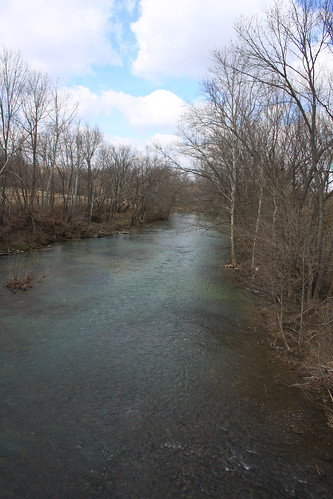
Kentucky's Chaplin River in winter.
(*photo credit)
June 3, 2023 Highlighting American Rivers Month
Our rivers are so much a part of who we are and where we call home. Rivers mark us in their presence and beauty, and yet they are quite fragile and require our ongoing protection. All nature lovers relate to rivers, even those not so near to us: the sacred Jordan and Ganges, the beautiful Ohio and Danube, the majestic Rhine, the mighty Amazon, and on and on. Rivers draw us like magnets and so we feel an ownership even when only experiencing them once in a lifetime, or only in photos or videos. Celebration extends to protection since rivers can be so easily trashed and damaged:
Water pollution. Our fragile flowing streams are subject to pollution: manufacturing emissions, domestic straight pipes, accidental oil spills, coal waste treatment pond leakage, runoff from cropland or animal waste areas, erosion from development sites, and on and on. Even with over five decades of awareness, waterway problems persist and enforcement is lax in many places.
Trash, junk, garbage, and litter. Floating "Kentucky Ducks" (empty plastic milk jugs) mar our local scenic rivers as much as sewage "straight pipes" dumping pollution into streams. We know that visible problems in an otherwise beautiful river turn off tourists and thus such carelessness has an economic impact. With increasing frequency, a throwaway culture can junk these streams and create an unseemly sight. Volunteers get tired of cleaning up others' mess and thus there is hope for more rigid local controls.
Dams and diversions. In recent years the past practices of damming rivers and channeling water away from waterways have been slowed and in some parts of America, actually reversed by removal of these dam barriers. Unfortunately, taming wild rivers has been a long-time mixed blessing in our country and more and more in developing countries. Hydropower is a renewable energy source with no emissions, but there is a disruptive environmental cost to the river's ecosystem through barriers affecting wildlife movement.
Recreational damage. Rivers are prized for their sounds of trickling and running water. I will never forget the experience of camping by the rushing Tongue River in Wyoming and the penetrating sound of that mighty stream's snow-melt in June. However, motor boats can drown out those pleasant sounds; ORVs along the edge of rivers at fords will harm mussels and marine life as mentioned elsewhere. Policing miles of recreational watersheds is difficult and requires citizen monitoring.
Development on Riverbanks. Most people like to spend time in or near water (oceans, bays, lakes, rivers, and streams). The affluent obtain second homes near waterways, but these mar scenic beauty. Let's champion restrictions on such developments.

Hyacinths adorn garden's edge.
(*photo credit)
June 4, 2023 Proclaiming Trinitarian Reflections
Each year we celebrate the Feast of the Holy Trinity on the Sunday after Pentecost. The Trinity is the deepest mystery of the Christian faith: Father, Son and Spirit, One God and three persons. Believers accept this mystery with a sense of utter reverence -- approaching a loving and sharing God. From revelation we learn what we could never come to from reason alone. Furthermore, we Christian believers come through both revelation and understanding to realize that our world and all its creatures (and especially human beings) are created in the image of God. Does some semblance of that divine Trinitarian nature emerge in natural theology and the world around us?
Even more so, is Christian activity somehow Trinitarian? The Creator's mark is on all creation; the Christian learns obedient sacrifice through imitating Christ, all are better manifested in an atmosphere of love. Creating, suffering, and loving are God's means of inviting us to share in the divine family.
The universe, and most especially our planet Earth, is a major expression of God's Trinitarian mystery. If our Creator is Trinitarian in the very act of creation, then the created universe is imprinted with the mark of the Trinity. Through faith, we seek understanding of the mystery of creation, the act of the Trinity at work. The Earth is a communitarian pulsating being that reflects the Trinitarian nature of our origins, our existence, and our destiny. With a sense of reverence, we respect this Earth as the very substrate of a New Heaven and a New Earth, redeemed and paid for in the blood of Christ. Dr. John Cross created a chart showing how the Truth of the Trinity reflected pervasively, but imperfectly, in creation. (Reference: Christianity and the Human Body, Proceedings of the ITEST Workshop, St. Louis, October 2000, p. 204.) The striving is deeply appreciated by believers.
The acting human being reveals this hidden Trinitarian nature through the reasoning process - involving creative experience, verbal understanding, and inspiring judgment, a mental process more thoroughly treated in Christian epistemology. In the process of curbing climate change and saving our threatened planet, we are called to resonate in harmony as collaborative human beings, also to imitate the Trinity. Inspired by the Holy Spirit, we are able to assist in a more wonderful re-creation, a process showing the Trinitarian nature of our world and our actions. The harmony of the three persons of the Trinity expresses itself when we act in harmony with each other. Thus, the human community manifests the ever-deepening imprint of the Trinity through proper actions undertaken together for the common good. For further reflection, read my book on “Resonance: Promoting Harmony When Confronting Climate Change,” available on Amazon Books. Comments are most welcome.

Edible landscaping with blooming chives.
(*photo credit)
June 5, 2023 Striving on World Environment Day for 100% Renewables
Many annual events are worth celebrating, but this World Environment Day requires us to be less celebratory and more serious about the threatened global environment. It is not a time for fireworks, but to fire up the works, namely the rapid and total transfer from a non-renewable (coal, petroleum and natural gas) economy to renewables (wind, solar, hydro, geothermal, tidal), and to do this with speed before climate change reaches catastrophic proportions. The get-up-and-go attitude that resulted in the atomic "Manhattan Project” during the Second World War and later by John Kennedy's "Man on the Moon Program" must be repeated, and more so because the vitality of our Earth herself is being threatened.
Many energy experts suggest that a rush order for renewables is feasible, as we have mentioned on numerous occasions. Renewables are ready even though they are still being technically improved; workers are available and would prosper; the public is in favor; and the Earth would have a chance to be healed. The drawback: financial resources are still in the hands of tax-haven holders and managers of undertaxed Big Energy. They will stretch non-renewable energy use to the last profit-ridden penny and have done so with a four trillion-dollar investment in the last decade or so.
Halting all forms of fossil fuel investment is a must and should occur ASAP. Cities, counties, states and nations are moving to a non-carbon economy by 2050 and over half are well on the way. The problem is with the other half, the ones who for some exceptionable reason desire to utilize cheap or plentiful fossil fuel as long as possible. By expanding of full cooperation, we know that onshore and offshore wind, utility scale and rooftop (distributed) PV, concentrated solar power, geothermal, wave, tidal, and conventional hydropower can meet 100% U.S. demand at mid-century – but some sort of enforcement is necessary. One wrench in the works is the ongoing warfare between Russia and Ukraine. Without a sanction-free environment one can hardly expect major fossil-fuel-producer Russia to fully cooperate.
Granted, this rush to renewables will take resolve and economic controls on the non-renewal status quo seekers. Nuclear energy is not included in the reported study because of safety and expense issues; nor are liquid biofuels included because of effective cost to move vehicles being so much greater than electric vehicles (EV). "If every new car sold today was an EV, in fifteen years almost every car would be electric." Certainly, the rise of electric car production is a very good sign. California has taken leadership role as has Texas in advancing renewable energy production. ed. The amounts of wind, water, and solar application will vary as still newer technologies come on line. It is important that peace be established and the world more at a collaborated level never before experienced.
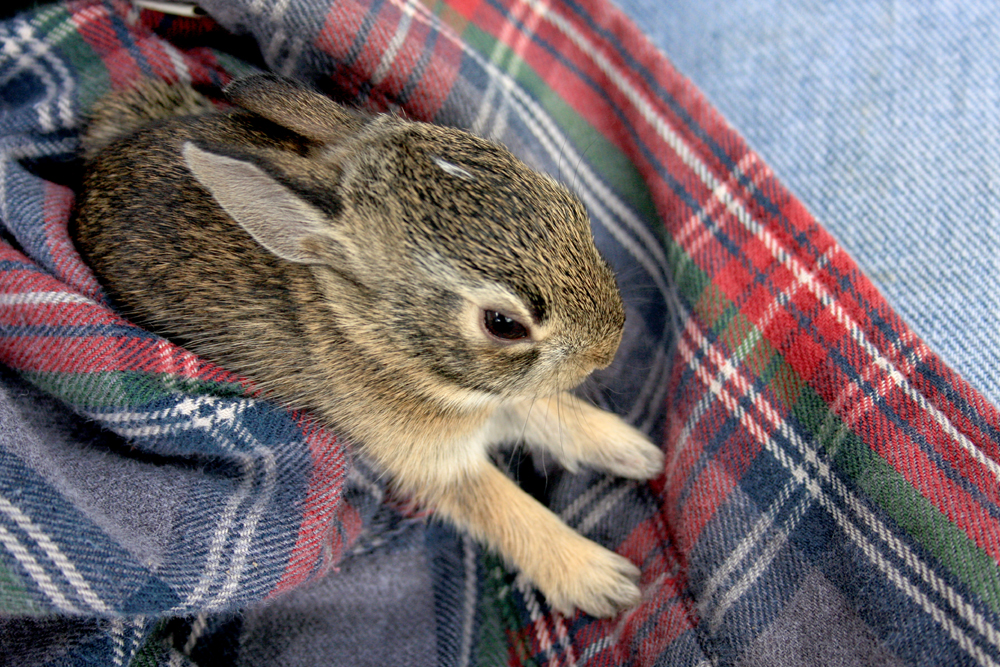
Finding a young cottontail while on outing.
(*photo credit)
June 6, 2023 Undertaking Outdoor Retreat Experiences
Reflection can occur in various settings, provided we are not too distracted b y other things. There are two major options: a retreat in a formal setting that may include interaction with a spiritual director; the other is perhaps the practice of a week in the solitude of the woods for communion with God apart from others. Let's extend this to all busy people -- namely, the public's opportune time to reflect and pray. Must the luxury of a retreat be for the affluent only, or can all commoners have the opportunity to commune with God? There's a time for everything under heaven.
For our physical and spiritual health, we all need routine outdoor experiences. To say that the kids have to be loosened from video games, and that the elders have to be allowed, pushed, or wheeled outdoors on occasion is the same struggle in our times. Even to the last few months of my mother's life, she thoroughly enjoyed the wheelchair ride around the neighborhood of the senior citizens center to see and identify blooming flowers; her love for the outdoors and flowers never left her. We ought to experience the seasons and weather patterns first hand in the grand outdoors. In this way all can become Earthhealers in their own right -- and they can rediscover the two-way communication with nature.
Would that all might have the opportunity to make a retreat in the wilderness -- and to do so once a year. Our distance with nature must be shortened and we all crave nature's beauty. With the environment under assault from many sides, this need grows all the more urgent. We are moved to respect: listen to nature's calls, smell the scents of the woods, taste the wild fruit of the land, feel the texture of the tree leaves and flowers, and see the fog coming up in the distant valley or thunder clouds rolling in. The use of all our senses in a particular place and time gives us an experience of the HERE and NOW, absolutely necessary ingredients for a true and authentic eco-spirituality.
We need access to low-cost retreat facilities -- not expensive institutions that take money to upkeep and limit clientele due to ability to pay. We need to have a woodland experience for those who would like to organize such a quiet time in nature. Outdoor retreatants can furnish their own lodging (in tents) and cook their own meals and thus omit high-cost cooking facilities and extensively maintained retreat infrastructure. Potable water, compost toilets, and shower facilities (also using solar hot water systems) are sufficient at park areas or can be furnished at low cost. Gatherings could occur in the seasonable months (May to October) using an inexpensive outdoor covered area. In fact, all that occurs at indoor retreat facilities would be on the agenda (even outdoor retreat masters), except that the facilities would be more primitive. This back-to-nature formal annual retreat setting has always been my favorite when I was physically able. I hope this inspires others to follow suit.
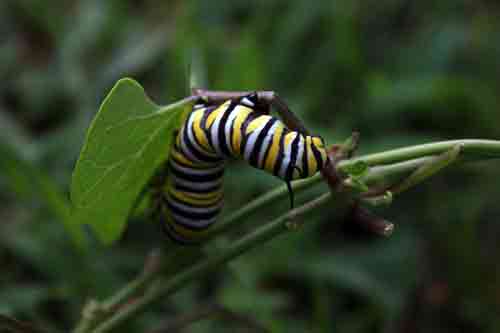
Caterpillar of the monarch, Danaus plexippus.
(*photo credit)
June 7, 2023 Confronting Academic Athletic Enterprises
Spectator sports bother me in many ways, though at times in life I have shown favoritism for local or regional teams. First, fans can go crazy over the impulse to win; the public can get in a groove by needing to watch sports; and athletes can be used, abused, and misused in the competitive world in which we live. In a commercial world in which sport managers and franchisees see dollar signs, some forms of unfairness creeps in. Perhaps professional athletes who have a relatively short career should get higher salaries, though they are far too high priced in my book. But what about college sports with their slave labor?
Finally, a few brave student athletes are organizing to get a cut out of the massive multimillion dollar profits going to their respective "academic" enterprises in game payoffs. This absolutely has nothing to do with academics, only the prestige of a major institution. Perhaps those who win or lose the games should in fairness get a cut for their talents and performances ought to be compensated. It sounds reasonable, but is that the end? Unions for professionals in sports may be worth the effort and do allow for higher proportions of the income received in a variety of sports to go to players. However, the entire enterprise of "semi-professional" college athletics is totally out of place and these talented young folks ought to be tested through other forms of sport farm systems, not, for heaven's sake, academic institutions.
One indirect solution is that ability to play in major college sports should be based on graduation rates of the particular sport at a given school -- but that could be an incomplete answer if the four-year athlete could be graduated with a knitting or jock degree, which others know means virtually nothing. Is it fair that athletes with high talent in sports but low in studies must endure no pay and still watch the school profit mightily for their performance?
A culture that glorifies the competitive spirit and the prestige coming from dumbed-down financial supporters being the life blood of an institution, shows just how insignificant brick-and-mortar establishments are becoming. These schools are becoming the handmaiden of a materialistic culture that operates on slave labor, while college management and especially coaches rake in large salaries. On the inequality side are talented but often non-academic students, who help with the financial intake by alumni and television networks, but are forbidden to earn an income. It is one more example of a basic inequality that could be eliminated by both minimum and maximum wage requirements. Those who pay for an education and become deeply indebted deserve more than pompons and pennants. Education is serious and needs separation from semi-pro athletics. Stay clear of the college football festivities AND promote non-academic farm teams.
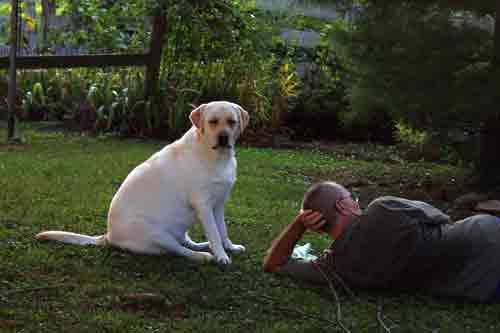
Sunset-gazing with devoted pal.
(*photo credit)
June 8, 2023 Celebrating Best Friends Day
Best Friends Day is a semi-commercial and authentic venture to recognize those who do not fit under the Mother's, Father's, Grandparent's and other such days or those special one in life at designated on Valentine's Day. Perhaps the ones who fit best on this day (if a poll were taken) are the special pets, especially dogs or cats and more sensate creatures. For ever so many people dogs and cats are best friends and become so much a family member that they are sorely missed when passing on.
Advertisements for this day mention reasons for having best friends: easing worries; never getting tired of another; sharing or unloading secrets and high points in life; and providing support in times of troubles. Many practicing Christians may select Jesus as their best friend and look no farther. But how about considering the plural or Best Friends Day and thinking about more than one friend -- human and animal? We have many friends, and the listing may have degrees in which pets and other creatures figure highly.
Animal lovers are filled with dog stories. At home when a youth, our family had a dog named "Tex" -- though different members called him different names depending on their degree of affection. I suspect I was the hardest on that dog's nerves, even though he remained a friend through his long life with us. Tex did not like me for throwing him in the pond on one hot summer day, and once shooting over his head when he insisted on lying down below the target we were using for practice. But he was a good friend and that leads us to understand that the loyal dog can truly be man's best friend. Tex had great abilities of which we (my siblings and I) were extremely proud; he could climb over a wire fence in a wink and overcome other barriers as well. He walked across the narrow (4-inch wide) wooden rails high up in a tobacco barn to be near us; he kept up with a vehicle in which we were riding at high speeds without stopping; he was a very faithful friend in need when we were depressed or saddened about something. Animals sense when it is time to comfort their companions, and Tex had an empathy for others. His bark never degenerated into a bite.
Friends are those we need when we lack companionship. Good friends and pets have this sixth sense and will come through and help out when needed. A dog will defend the loved one with his or her life, be watchful in the worst of weather, and guard one when hiking or jogging. I once had a dog thinking she was my protector and liked to jog along. Once I penned her in just after she had pups, for fear she ought not over exert herself in running. When I started to jog, she bounded over barriers and was at my side for a three-mile jaunt -- two days after delivering a batch of pups. She insisted that I must be guarded. Some need animal friends at times of dying or when recovering from illness. In fact, we all need friends and ought to cultivate more of them.
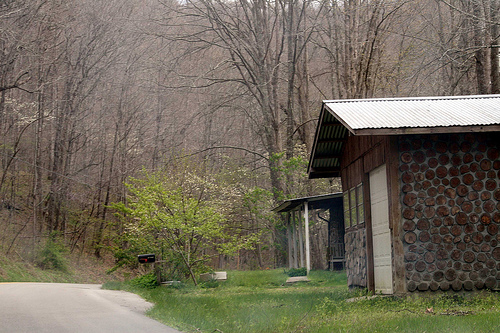
Front porch in spring of cordwood home, Appalachia - Science in the Public Interest.
(*photo credit)
June 9, 2023 Blessings of Porch Sitters
Today is Senior Citizens' Day and one of the great blessings is that those who are elderly and not fully active can have the luxury of sitting on their porch -- if they are so blessed with one. Many of Appalachia's most humble abodes have such porches, especially front ones. One old lady summarizes the art of porch sitting: "Sometimes I sits and thinks; other times I just sits."
Sitting on the front porch is an art with many benefits. First, the sitter gets outdoors in the fresh air for a period of time, especially during warmer weather but some confirmed sitters endure the rain and cold to sit in that halfway structure between outdoor elements and indoor claustrophobia. Second, this allows the sitter to be engaged with the local world and to see and know who is coming and going, what the weather is like, and how passersby respond to it. Third, front porches give a sense of public exposure and the chance to talk with neighbors and strangers. These characteristics make a porch truly Appalachian.
Porches come in every size and shape. My grandparent's large brick house built in the early part of the 20th century had front, side, and back porches on which my granddad would sit in his retirement years. His choice of porch depended on the weather and time of day. Some prized memories are sitting with him on the front porch, which was surrounded by ornamental bushes giving some shade, even though in a westward direction for catching the late summer sun. The relationship that we had with each other was similar to that of the father and youngster in "To Kill a Mockingbird," with the movie's porch swing as the pivotal point.
Perhaps porches were at their high point in pre-air conditioning times; they were often the cooler part of the total residence, and thus encouraged spending time on them, especially in the summer evening before it got dark. Just being willing to sit there and reflect -- or just sit is a sacred moment. My current residence, built about a century ago, is blessed with front, side, and back porches. My side porch is a perfect place to observe the rising sun and movement of birds and squirrels, and assess the day's upcoming weather. I still prefer to move about outdoors but advancing seniorhood makes sitting a possibility.
Porches have a number of utilitarian purposes: they are good receptacles for gifts, mail and express packages; they become parking places for dirty boots and implements; they are visitor entertainment places and where some can play musical instruments and project the sound. Porches protect entrance areas and serve as bridge between the greater outdoors and home interiors. Porch roofs can serve as anchors for solar panels and for collecting rainwater. Porches add dignity to the house and can be screened or boxed in to become greenhouses. Let's hope porches stay around and well occupied and that more of us are inclined to sit on them.

Flame azalea, Rhododendron calendulaceum. Harlan Co., KY.
(*photo credit)
June 10, 2023 Returning to the Holy Land
The Holy Land can bring pleasant dreams or nightmares. When this reflection was first composed some rockets fell on Israel space and the response was air strikes on the captive people living in the Gaza Strip. When will two peoples decide to call it off and start living in mutual prosperity? Daydreaming about peace in that hostile part of the world seems a distant exercise, but ought it be? What if, yes, what if the Israeli and Palestinians could come together and decide that peace will benefit everyone? What if a peaceful Holy Land involves inviting all the people of the three great religions (Christianity, Judaism and Islam) to come as tourists and pilgrims and enjoy the rich cultural flavor of the place and the holy shrines such as the Holy Mount of Zion?
God wants us all to share resources of the world as brothers and sisters. And sacred and historic places are resources worth sharing in some fashion, at least if many benefits result by serving visitors who come to holy sites. Mutual peaceful progress together would encourage all people of faith and others to come to their real homeland, at least in a remote sense. Not only are there immense spiritual benefits, but economic ones as well. Think of it, if every believer of the great religions (and others besides) could come once in a lifetime for a few days of visiting this sacred part of the world: airplanes, infrastructure maintenance, food and lodging, and on and on would be needed. That is over four billion people who would need to come at a rate of 1.2 million a week (with two weeks of free time a year so the serving people could rest). Some may want a second visit.
Think of the demand for restaurant managers, cooks and servers; think of the number of recyclers and landscapers, of police and shopkeepers, count in managers and cleaning personnel at hotels, motels and camp sites; include utility workers, growers and processors of fresh foods; and don't forget transportation people to handle the crowds. The economy would boom and, if all were treated hospitably, the good will generated would be enormous. Perhaps satisfaction of each pilgrim and tourist would translate to a global good will and reduced need for military presence.
Is such a goal achievable? Well, in a wild stretch of the imagination, it is possible, for millions go to Rome and Mecca and millions have come over longer periods of time to the Holy Land as well, but not in these anticipated numbers. Part of the mentality change is that the Holy Land does not "belong" to the residents alone. The Holy Land belongs to the world and thus it should be shared in some fashion as "home" to all believers. Our problem has been that some Israeli and Palestinians claim that "home" exclusive of all of the other claims. What was regarded as a promised land for some, is now a promise for a world to be celebrated together in the fullness of one God and Lord of all.
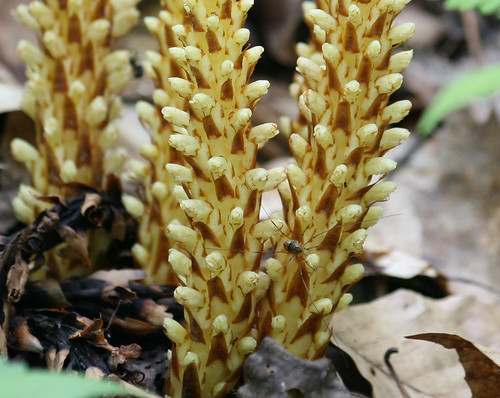
Unusual native Kentucky plant: squaw root, Conopholis americana.
(*photo credit)
June 11, 2023 Being Part of the Body of Christ
The fact that there is only one loaf means that, though there are many of us, we form
a single body because we all have a share in this one loaf. (I Corinthians 10:17)
To help us cultivate the spiritual nourishment and balance we need to survive as Christian believers we turn to Jesus as Sacred Sacrament, the focal point of this day. Consecrated bread and wine, which were made by human hands shows a spiritual empowerment. People steeped in the Eucharist are called to help heal our wounded Earth through being cooperating hands, heads, and hearts. The power to consecrate is not from human, but divine initiative; we call forth the Lord who is with us and is worthy of celebration. This is because our mission seems impossible, for Earth is in massive trouble and we appear so powerless on how to initiate healing to pandemics, warfare and climate change.
Our sharing among believers makes this more than a single individual crusade; this is a mission to those working in a collaborative fashion. If we can share with the Lord in the Eucharist, then we discover the power to share with all people in the virtually impossible task of rebuilding a broken world. The Lord is our nourishment, our hope to overcome looming catastrophe. Without the Lord, the evil one would appear victorious and we would be reduced to paralysis. With the Lord we experience empowerment to do mighty deeds as St. James says: "I will prove to you that I have faith by showing you my good deeds" (2:18). The fact remains that we need to balance our deeds and our words -- "This is my Body" is now the Body of believers who act in Christ as agents of change.
The change is not for me apart from others; rather, this is a change where the WE are incorporated into a working force for the good of all creatures. The damage to our Earth occurs when private individuals from colonists and exploiters to slave masters and autocrats have sought to own what is not rightly theirs. Such human "masters" were never intended, and to think that this source is the Bible is to fail to discover the truth in Scriptures.
The act of believing that we are now a Mystical Body of Christ takes faith; the act of healing a wounded Earth also takes faith, and this is the same faith -- a faith in Christ. This faith contains the elements and include our trust in God’s ongoing grace. We must become and stay energized and ready for the work ahead. We must overcome the barriers of human difficulties that weaken our bonds of cooperation. On our part we must firmly believe that spiritual victory is possible, if we join humbly and sincerely with others of good will. Our success is not automatic, and results are the product of our hard work. Whether this can be achieved here and now is still an open question; as people of faith, we need God’s help.

A honeysuckle, species native to Japan.
(*photo credit)
June 12, 2023 Composing Some Haiku
Haiku is a Japanese verse form, rendered in English as three unrhymed lines of 5, 7, and 5 syllables and usually about nature. Below I share compositions made over the years. Try your hand.
Butterflies come back
all the way from Mexico
to make us happy.
Oaks stand straight and tall
giving us feelings of strength
to confront our world.
Yes, radical change,
while Americans are lost
in their own dream world.
It's a brave new world:
climate change, air pollution.
We must take some risks.
Is climate changing?
It surely is, my good friend;
Build yourself an ark.
Whatever we say
comes back to really haunt us,
whether good or bad.
Nuclear power:
peace or war, good or evil;
let it die in peace.
Springtime comes again
Yes, the mountains skip for joy
all vested in green.
We'll take the pathway
through the forests tomorrow
to see, smell, touch woods.
Great is the river
flowing gently past our door
fleeting like our lives.
It takes far less time
to create this haiku page,
than to make it work.
Floral Titles Abound
By Al Fritsch, SJ
These are some possible titles for flower arrangements:
Spring’s Refreshments
Poetry without Words
Divine Paintbrush
My Landscape Delight
The Last Rows of Summer
Color Magic
Nature’s Answer to “Why”
Life in the Bud
The Meadows Kiss
Fragile yet Enduring
Silent Poetry
Unique Taste
Nature’s Spontaneous Smile
Elements in Paradise
Roadside Distraction
Window Box Delight
Enchantments for a Moment
Healing Presence
Planting Beauty All Around
Singing to the Meadows
Worth a Million
God’s Mercy Indeed
Health for the Hospitalized
Others?

Male carpenter bee, Xylocopa virginica.
(*photo credit)
June 13, 2023 Pickling in All Its Glory
June is the month when we harvest cabbage and the first cucumbers, and my parents always preserved these and other vegetables in special ways. We had large five-gallon crocks that would hold cabbage cut into shredded sauerkraut, along with cucumbers left whole to be pickled with spices. Each needed a strong salt brine that required changing liquid during the pickling process. The sauerkraut was trampled by a young barefooted (after careful feet washing) family member who could dance in the crock -- an honorable calling for those with no cuts on their feet. The end result after much tender loving care was sauerkraut, or the main ingredient in many of the Alsatian dishes that was appreciated by our extended family. Many of my ancestors came from the watershed of the Sarre River -- some prime pickling country.
The pickling preservation practice does not stop with these two vegetables. Everything from root vegetables and fruit and from eggs to pigs' feet can be pickled, if one makes the effort and has the produce needing preserving. One can pickle carrots, beets, turnips as kraut (one of my favorite dishes), artichokes, okra, cauliflower, dilled beans, whole mushrooms, asparagus, horseradish, kohlrabi, pearl onions, green spiced tomatoes, and hot and sweet peppers of all varieties. As to fruits, besides pickled watermelon rinds (another one of my mother's favorite preparations), one can pickle cantaloupe, figs, crabapples and regular sliced and spiced apples, pears and spiced plums -- and more.
With all our modern conveniences we tend to overlook the importance of salting in food preservation that has been associated with Europe and other parts of the world. This was a pre-canning way to store excess fresh foods, a part of culinary history even before the Roman conquerors prized salted and cured hams imported from northern Europe. Pickling could be regarded as a variation on this meat-preserving process; both pickling and curing are based on use of large amounts of salt. One of the only drawbacks to this good form of food preservation is the excess of salt eaten by the food consumer. Where people perform large amounts of heavy work, salt consumption is not a major problem; for those engaged in lighter occupations and special diets, pickling may be a no--no.
Actually, salt brine is not the only pickling medium. Vinegar, ethanol, and vegetable oil are also used to preserve food from harmful bacteria. Even sodium hydroxide (lye) has been used. The mountain people of Appalachia leached the lye from wood ash, and this in the form of a highly basic solution was used to treat corn to make hominy. There are other known olive recipes that use non-brine liquid preservatives. Look on the Internet for the National Center for Home Food Preservation for various pickling details.
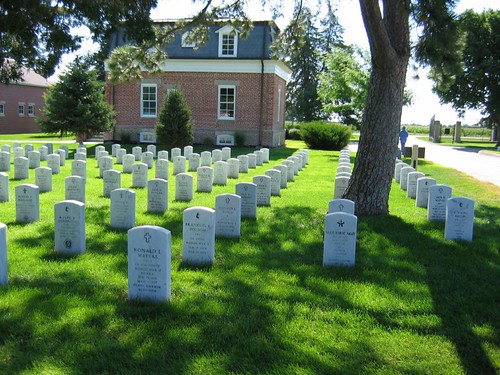
Diverse backgrounds found while exploring national cemetery. Ft. McPherson, NE.
(*photo credit)
June 14, 2023 Considering Patriotism, Migrants, and Our Flag
Many native-born Americans take their citizenship for granted; they regard patriotism as an old-fashioned virtue that is accepted, but not worth much reflection in our busy world. That temptation is hardly the case with many naturalized citizens and undocumented workers who take their American way as worthy of sacrifice and demonstrations of special loyalty. For all true citizens, this Flag Day has a deeper meaning, for it is entangled in a fading American Dream of a next generation surpassing the last one.
Patriotism takes on added importance as this country holds back on needed immigration reform legislation. This year, many will seek one more time for fair and just immigration laws. Some advocates will carry and wave the American flag proudly and manifest their patriotism in doing so. All the while, illegal migrants (up to eleven million) in more silent ways want the rest of the country to know that they deserve recognition for the valuable work they do, especially in areas where others refuse to take the lower-paying but difficult jobs. In fact, without them much of our food materials would go unharvested.
In these reflections on this Flag Day, I recall coupling flying the flag at day and night with solar renewable energy production. It is improper in this country to fly the flag at night without a light shining on it. This poem was made when installing a renewable energy or solar-powered spotlight on the flag at the ASPI center at Mount Vernon, Kentucky, at night. It was written during the horrible period of time following September 11, 2001.
Fly It Bravely
Too much blood has been shed by patriots who gave all,
with their lives, their limbs, their peace of mind.
Then many returned to home soil, flag draped,
taps in the background, a sob, a word, and then to dust.
For their sakes we fly this flag with pride.
We may not need a constitutional amendment to act,
but free citizens treat this emblem with respect,
not burning, not desecrating it through commercial greed.
Respect calls for not flying the flag overnight
in the dark. Thus we suggest and install a solar spotlight,
with daylight ‑‑ renewable energy ‑‑ stored and transformed,
so that the sun never sets on Ole Glory.
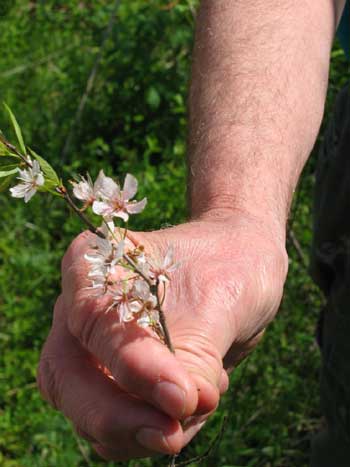
(*photo credit)
June 15, 2023 Supporting Urban Forestry
To say we support all forestry is an understatement, for we want the Amazon to flourish and our Appalachian marginal farmland returned to trees. Tree planting and encouragement is truly ecological, but we could emphasize areas of greater impact – and urban forestry is one of these. We know how cool it is to travel on a road this time of year and the heat of open spaces seems to disappear when we pass through groves of trees. Urban areas are affected in much the same way by presence or absence of trees.
Many urban areas lose trees due to clearance of utility lines as well as to storms and disease. It takes an extra effort for local residents to designate space for more trees. Choices as to what is selected are critical as to leaf coverage, height, affinity to soil, and disposal of leaves. Designating trees for particular residents has the effect of making forestation a personal enterprise.
Energy savings. Tree shade can and does reduce central urban temperatures in summers by as much as ten or twenty degrees. Air conditioning savings can be immense.
Wind barriers. Winter conditions can also be moderated by the presence of trees, which can serve as wind barriers. Less space heating is necessary in such urban areas.
Beauty. Urban trees add beauty to congested landscape. Many tell of the excitement at looking out a window and seeing trees with their bird perches and swaying leaves. The extra greenery is exciting to a nature-starved population.
Fresh food. In areas where fresh food is scarce, the presence of fruit and nut trees can be a godsend. Many of these types do not have major fall cleanup as do oaks and maples, but offer a form of life so craved by many urban dwellers.
Habitats. Birds seek and find safety and nesting opportunities in trees, the presence of which attracts more of them to the urban areas. Tree roots and understory also add habitats for ground squirrels and other varmints.
Moderate water excess. Rain water can be intercepted by trees and thus moderate storm water impacts. The excess water can be collected in nearby lakes and streams and reduce immediate flooding damage.
Cleaning agents. Trees can serve as natural biological filters and actually remove particulate matter pollution. At the same time soil can be decontaminated by the presence of certain tree species.
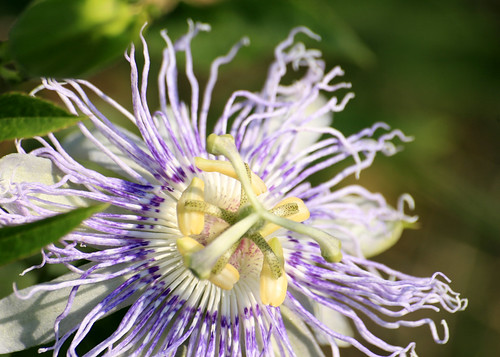
Kentucky "weedy" native plant, Passiflora incarnata.
(*photo credit)
June 16, 2023 Healing Earth and the Sacred Heart Devotion
Today is the feast of the Sacred Heart of Jesus, which occurs in the week following Corpus Christi. This devotion goes back to the 17th century and was initiated through visions of Christ appearing to St. Margaret Mary Alacoque (1647-90), a French Visitation nun. It expanded from local community devotions to Poland and then in 1856 to the universal Church. Saint Claude de la Colombiere was instrumental in drawing Rome's attention to the devotion. Pope Pius XII's encyclical Haurietis aquas explains the theology of using the symbol of a heart for Christ's love and mercy, in contrast to "Jansenism" that exaggerated the individual's sinfulness and unworthiness. The contrasting Sacred Heart devotion is on Jesus' outpouring of his entire being for all of us.
Ecological significance. Today, the Sacred Heart devotion needs expansion from effective forms of devotion that tries to make reparation for the effects of personal sin in our world to the destruction of our fragile Earth by human greed; we must introduce the dysfunctional economic culture of consumerism. Repair is evidently needed and still many refuse to accept that we have as a people done anything wrong, much less initiate repair or renewal of our damaged Earth. In the past, emphasis has been in environmental efforts to expose and stop the misuse of practices causing air, water, and land pollution. However, individual recycling and other corrective measures by individuals have not proved sufficient; this is due to counter forces alluring people to spend and use more and more resources for luxury purposes.
Domestic environment. As a spiritual practice consider enshrining homes with the picture of the Sacred Heart (peace coming to those homes), along with offering our deeds and prayers each morning for published or private intentions. Installing devotional pictures has expanded beyond Catholic to Protestant homes as well. These are to be broadened to include prayers and petitions that those in areas of influence may initiate controls on wasteful squandering of resources. This includes not only halting pollution in all its forms but repairing our world through environmental actions. The thrust today ought to be to expand from domestic and individual activities to appeal to the Lord to break the social addictiveness of overuse of consumer products. This is a personal way to curb climate change.
The environmental crisis is an expression of the diabolic power of greed and worldly materialism in the world around us. Secular measures such as recycling, conservation, and renewable energy sources are all necessary; furthermore, we must pray for the strength to work together and spread Good News that we can still save our wounded Earth from catastrophic disaster. All believers are called as individuals and in groups to heal what has been damaged. Global collaboration is an expression of Christ’s love for us and a component of the Sacred Heart devotion.

Fr. Al Fritsch with fresh kohlrabi from his Kentucky garden.
(*photo credit)
June 17, 2023 Juggling Day and Focusing
We talk about "juggling" in several ways. Most often used in modern society is completing a varied schedule of daily activities while keeping everyone happy. Parents, from soccer moms to two-job dads, find juggling and multi-tasking a daily challenge. All of us find juggling schedules with other busy souls a weekly challenge. However, there is a totally different way of seeing the busy day and that is to imitate the professional juggler, even if unskilled, in correctly juggling our schedules. Yes, we need to keep intensely focused on what is being done at a given moment.
I am not good at professional juggling, but I have a skill somewhat akin to juggling, and one that I discovered others hesitate to try. Many years of hoeing tobacco gave me the chance to carry the hoe to and from the field balanced vertically in the air on my little finger. There is an art to it and a danger also, should the hoe become imbalanced and hit someone on the head. And I didn't think the feat noteworthy until years later when a bystander said this was like juggling. Well, the key to a good performance of balancing a hoe on the tip of the little finger is concentration; this is FOCUS on what is being done.
We often hear that a person looks another in the face and actually listens attentively, fully concentrating on what the other says. That's as much an act as juggling and demands omitting other thoughts. We listen so as to give total attention to the words of another. What if we focus on some project and continue focusing long after we need to move on to the next project? Attention spans move with the crowd and we are often confused by a multitude of other worthwhile projects. The next petition drive buries the last with a flash and we tire easily in attempting to be a juggler.
Besides having a practice akin to juggling, what can we do to regain a sense of the focus we had as infants, only calling attention to food or diaper changes? What if we cultivate moments of intense focus: in conversation, in reflection, in prayer, in hearing what another is saying? What if we resolve to meditate with care and respect for God at chosen times and places? Can we visit the sick and give them full attention without thinking about another stop waiting down the road? Perhaps, better planning of time with sufficient amounts for each exercise would prove to be better for focusing.
Juggling means more than doing several things in the course of a short time; juggling means concentrating and centering one's attention on a particular practice and doing it well, with each practice being given its due time and effort. We need to start focusing on the importance of each act we do. What we learn from jugglers is not only a show of skills, but also of their mental state when acting. Then let's start our own form of juggling.
![IMG_0011[1]](https://farm4.staticflickr.com/3922/14437232572_eecc914976.jpg)
St. Francis in the Garden.
St. Elizabeth of Hungary Church, Ravenna, KY.
June 18, 2023 Affirming a Sense of Balance
“The harvest is abundant but the laborers are few; so ask the master of
the harvest to send out laborers for his harvest.” (Matthew 9:37)
Harvesters must be balanced folks, for the work of gathering is difficult. We shudder when observing those in high places such as tight-rope walkers, skyscraper framers, or steeple climbers, and admire their art of balance while going about their business. Little do we realize that their nerve in high places and ease in the elements under trying circumstances does not surpass the call to be working in a godly fashion, immersed in a world of secularism. Most certainly, godly work takes a delicate balancing act and surpasses those who work in physically high places. We are amid the world's mammon and these are trying circumstances, especially when the evil one tries to upset our balance.
Though many want us to concede to secularism and to wink at injustice, greed, lust, and self-centeredness, we become painfully aware that we have strong allurements all around us -- and yet most do not believe in the evil one, since secular values are so confusing about good and evil. Our response must be firm and yet joyous. Interiorly, with some effort at trying to do the right thing, we find peace with God amid a troubled world and do not allow the troubles to invade our inner peace of soul. That is assisted through sacramental nourishment and trusting in the power of God working within us.
Exteriorly, the balance involves being present in the world but not part of it. Thus, we are challenged to be countercultural in major issues. Certainly we may enjoy foods, fashions, and events, provided we do not succumb to the enticements that go with them. But the big issues of justice for all, respect of human dignity, civic challenges to the immoral, and refusal of the culture of death are in need of reemphasis in troubled times. Being silent means we accept what others hold and inwardly we know is to be rejected. Countercultural activity may involve stating what we hold while others deride us for not being more secular. Yes, the world is alluring and we can succumb to the evil one.
The deepest level of imbalance comes in accepting the power of wealth in the world. Those "nice folks” with money want us to do what they regard as the proper thing to do in this age. It is their expectation that we conform to the system and be friendly to their cause. On the contrary, the balanced person sees beyond the quiet pressure of wealth and speaks up for justice for everyone – and this takes a degree of courage. If we persevere and act in a godly manner amid troubles, we retain our inner peace of soul; this is the critical balance that unites believers while working together in seeking greater good. Then we can answer the call to be the Lord’s harvesters in this time of critical need.

Solomon's seal, Polygonatum commutatum, Lily family.
(*photo credit)
June 19, 2023 Knowing the Significance of Juneteenth
On June 19th, 158 years ago Union General Gordon Granger led his troops into Galveston, Texas and declared that the Civil War had ended; the slaves in rebellious areas were free (the Border States' slaves had to await the 13th Amendment to the Constitution). What made the date so significant was that the Texas slaves had little access to information and did not know about the Emancipation Proclamation issued in September, 1862, saying that all rebellious states not returning to the Union by January first of the following year, 1863, would have their slaves automatically freed. Now, on this June 19th, the word reached the farthest extent of the Confederate territories and the ex-slaves celebrated this as though it were July Fourth -- Freedom Day.
Promoters of the day tell why they celebrate:
J -- Juneteenth represents the joy of freedom -- the chance of a new beginning.
U -- Unless we expose the truth about the African-American slave experience, Americans won't be truly free.
N -- Never must we forget our ancestors' endurance of one of the worst oppressive experiences in human history.
E -- Every American has benefited from the wealth blacks created through over 200 years of donated slave labor, and Juneteenth allows us to acknowledge that debt to our nation.
T -- To encourage every former slave-holding state to follow Texas' and Oklahoma's example and make Juneteenth a state holiday.
E -- Everyday in America, Afro-Americans are reminded of the slavery era. Juneteenth counters by reminding us of the promise of deliverance as an operative principle for gaining greater freedom.
E -- Even on the journey to discover who we are, Juneteenth allows us to reflect on where we've been, where we're at, and where we're heading as a people.
N -- Never to give up hope is the legacy of America's enslaved ancestors. It was this legacy that produced black heroism in the Civil War and helped launch the modern Civil Rights era. It is a long-term and often hidden legacy we celebrate today.
T -- To proclaim for all the world to hear, that human rights must never again become subservient to property rights.
H -- History books have only told a small part of the story; Juneteenth gives us a chance to clarify the record a little better.

June-blooming Rhododendron maximum.
(*photo credit)
June 20, 2023 Cultivating Spiritual Nourishment
A balanced Earth healer needs spiritual nourishment. The primary nourishment is the spiritual food offered by Christ himself in the form of his Body and Blood -- a deep mystery for some and a stumbling block for others. Besides the sacramental nourishment featured in the Feast of Corpus Christi (Body of Christ), which we celebrated Sunday before last, we find other sources of spiritual nourishment:
Literature -- We all need some spiritual reading in the course of the year. We get inundated with secular materials and advertisements on every side, and this must be countered by some serious spiritual reading from the classic Doctors of the Church, lives of the saints, or popular religious spiritual reading. Excellent materials are available and can be purchased on line.
Speakers -- At various times in the year good speakers are available in the neighboring universities, parishes, or through organizations, especially at special times of the year. Keep aware of the schedules and make an effort to go to one or another event when they occur. A good speaker has a way of encouraging us to continue pursuing a special course of reflection.
Events -- Missions, revivals, conferences, and workshops are other means that people use to revive their own spiritual lives. Unlike the ongoing nature of reading literature, these are rare occasions and yet have ways of changing a person's life in a dramatic fashion.
Conversation -- Saints such as Benedict and Francis were known to have sincere spiritual conversations with friends that deepened their commitment to forming religious communities. Many others admit to the benefits of being able to talk to others informally or in a more formal setting with a spiritual director. One-to-one interaction appears far more influential for many people than merely going off on one's own for reflection.
Retreats -- Another form of personal interaction (here with the Lord) is the annual or regular opportunities to reflect in some special time, place, and manner in what are called "retreats" (see June 6th). The reflection period that one sets aside opens us to special graces from the Lord.
Daily prayer/reflection -- Daily prayer is our regular manner of spiritual nourishment and is done through conversation with the Lord through our own words and periods of listening -- and it may differ considerably with time and age (discursive prayer, meditative reading of Scripture, prayerful writing, and other suggested forms of meditation or even oral prayer with others). A more thoughtful reciting of the Prayer of the Church and singing in choir is the daily prayer that have given spiritual nourishment to many throughout the ages.

Admiring moon in quiet of night.
(*photo credit)
June 21, 2023 Considering a Dozen Summer Suggestions
Today we greet the Summer Solstice and so we turn our thoughts to heat and the benefits and risks of the Northern Hemisphere's season. Here are some hints to soften the harshness before us:
* Protect skin from too much sun using sure and tried sun blocking formulas. The cheapest practice for those who have tender skin is the broad straw hat -- though I haven't worn one in years. Added for the fair skinned is to avoid direct sunlight in midday and do outdoor exercise and gardening in morning or evening;
* Watch out for overheating as a standard safeguard. That becomes a problem when doing strenuous work or recreational activities for all ages in the middle of a hot summer day;
* Keep liquids handy when on hikes or working outdoors;
* Get plenty of sleep, for these are the long days of the year and many of us do not like to sleep during daylight hours, either in the morning or evening;
* Don't let increased activities reduce your book reading habits of cooler times. There's always time to learn more and enjoy good books, especially reading outdoors under a shade tree;
* Don't forget about the unpleasant but valuable tick search after coming in from the outdoors, especially after moving through weeds and wooded areas. Lyme disease is a growing problem;
* Do some extra woodland camping and hiking when you can find the time, for this is the perfect season. Sometimes you can combine pleasure with business that save fuel costs;
* Pick some wild berries and fruit this summer. I do not enjoy the task as much as when younger, but there is still something special about eating off of the vine or tree. You don't have to be extravagant, for a small handful can prove satisfying;
* Visit a local historic or scenic site that you have put off seeing because the weather has never been right. You may wish to bike to the location or to spend an afternoon at the event;
* Take in a music festival, for summer is the best time, and take someone who does not go often;
* Think about an autumn garden. We need to take this part of gardening seriously even before mid-summer, for gardening can be an all-year exercise; and
* Give a little extra time for reflection and prayer during the summertime. It may prove harder than during cooler seasons.
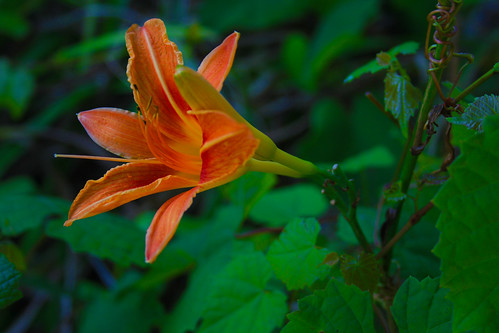
Daylily by Kentucky rural roadside.
(*photo credit)
June 22, 2023 Maintaining a Composter
In many of our residences some space exists for turning domestic and yard wastes into compost for gardens and flowerbeds. Others may not have yard space, but rather should consider small indoor composting boxes as an alternative. The bin has to be in an accessible place, removed from burrowing or disruptive critters, and contain sufficient earthworms to assist in converting waste to humus. An easy form of outdoor bin involves an open front and overhead and three-sided "C" made from discarded pallets nailed together at the ends. This allows for rain water from above and air to circulate through slats into the discarded materials. Indoor bins will have to be mixed and some moisture added.
When assembling a composting heap consider coarse material such as tomato vines and stalks as a bottom level for improving aeration. Coffee grinds, egg shells, and vegetable peelings ought to be added perhaps twice a week. Some soil from excavated paths or ditches could be added as well. No meat scraps or greasy materials, please! The wrong garbage additions can attract local varmints, such as raccoons and polecats or even rats.
The optimum health of the compost bin requires the right amount of moisture, air and materials. Some turning of the material is best performed by the use of a pitch fork or shovel. Some more serious and higher volume composters require two or even three bins side by side. Make sure the earthworms stay healthy (moisture in the beds), for their presence is important for the composting; over-sunny places may prove too hot for the worms.
People seriously concerned with composting will delight in getting just the right variety of earthworms, for there are many. However, native earthworms really are acclimated and serve quite well. Where lacking, native or other earthworms may be purchased commercially. Some protect compost bins with rat screen on the bottom and sides and even add a gate; much depends on the composition of the contents and proximity to varmints that might spoil things. Composters may decide to replace pallets every so many years, as sides rot away along with the compost. Prefer pallets that are not pressure-treated or painted.
Indoor compost boxes in the right place can be just as serviceable as outdoor ones. Kitchen wastes can be placed in the box and with proper mixing to aerate and a little moisture and earthworms, can turn wastes into valuable humus for potting soil destined for garden and flower plots. Composting is simple, for it is nature's way. This irritates some commercial establishments because they seek to make money on natural composting, and have now introduced turning and tumbling machines of all sizes. If you are not composting on a massive scale, the turning fork allows for good physical exercise.
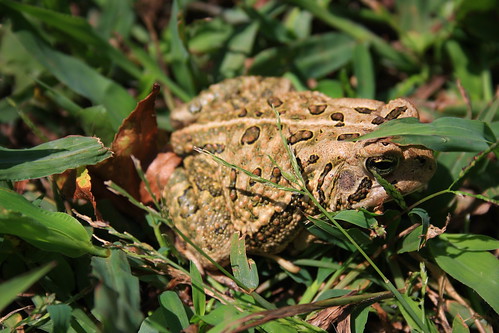
Fowler toad, Bufo fowleri, "hiding" in grass.
(*photo credit)
June 23, 2023 Discussing Brain Drain
"Brain drain" refers to the movement of professional or highly skilled or trained individuals and groups of people from one area of a country to another, or from one country to another. Actually, brain drains occur throughout the world where rural areas are affected by out-migration and experience loss of talented and educated young people to more affluent regions. This both depresses communities that suffer from the outflow and costs those who can least afford the loss. Some "drainees" may return earnings to the ones left behind, but their talent is lost to communities who need their experience in order to prosper. Even Germany experiences an interregional brain drain as people from Saxony and East Germany move to southern and western parts of the country.
Poor nations provide skilled workers for affluent lands that have relative shortages and higher pay scales and well-equipped facilities. Some 25% of the health care workers of Africa are now working in Europe or America. The situation is terrible in some of these donor countries due to lack of caregiving experts, especially those dealing with cancer victims. Poorer areas have difficulty retaining their staff for combating AIDS, malaria and tropical diseases. In the Americas more of the Haitian medicinal personnel come to affluent parts of North America. Cuba is an exception.
Appalachia also suffers from out-migration of our skilled and professional native people to nearby or distant urban centers. Still, the region is recipient of medical doctors and health care workers from the Philippines, India, and relatively poorer parts of the world. Thus in America's inner-city hospitals and rural areas, one finds people from lands that can hardly afford the drain of their own medical personnel replacing the drained fields of a more affluent nation. This is doubly onerous for impoverished areas that supply the primary education and sometimes even up to and including professional training, with scarce funding and little return compensation for this education. Nor do we find any movement in the world for a just compensation by the wealthier nations and regions for this terrible educational burden. When money is given in the form of public or private assistance, it is regarded as "charity" in a somewhat mistaken designation.
A good solution is to persuade people to stay put, but that is nearly impossible. A second suggestion is that professional people would not migrate unless they are sure replacements have been found in the needy area from which they come. Unfortunately, that would at best lead to a chain reaction whereby one comes from a region and gets a replacement from a needy region, and the least well off is ultimately the area paying the greatest price. Certainly we ought to train people in the more affluent areas to handle their own needs and to swell ranks of Doctors without Borders and Peace Corps and similar organizations.
Meaningful Work
By Al Fritsch, SJ
I've always considered work as something unique, something very special in my own life. I've always liked the fact that I've been asked to work and that that work will be appreciated, whether it was on the farm when I was a kid, or later when I was in the Society of Jesus. Many times we've been asked to work at certain specific tasks, where people appreciate what we do. It makes the work so much more enjoyable. We may find it more meaningful if we offer our work to the Lord, as part of our sacrifices we are called to make each day. Work then becomes part of our life;it helps define us. I can respect that work in many ways. We should respect the fact that we have been called by the Lord, and looking back and seeing the good things we have done, shows that there is a positive, higher force at play. Part of our living with the Lord and very close to God's work on Earth. So human beings are called to help create and build a better world.
Work is short-lived, as we're here for only a short period of time;very short, if we listen to scripture, telling us how quickly life comes and goes. This short span includes the precious time between when we were too young to work, and also when we're too old.In that time in-between,which can vary considerably depending on health and circumstances, we are asked to do something different than what has been done before by others, something that is really important and contributes to the welfare of the world itself. It's our privilege to be able to make a mark on society.And this adds to what my problem is with maybe being too judgmental. I see people who are living, from my perspective, very healthy lives. I know they call themselves retired and consider themselves free of work because they have enough resources to keep going. I feel bad about that, because they are at an important age for contributing to a needy world. They usually are people with good experience and outlook,and now they are ready to show the world something that needs to be done. Yet it's at that very best time when they quit, and retire.But if their retirement shifts to a change of work there's something that can be more meaningful for them. Then I'm not against that at all. But the fact that some people feel that it is important just to let go and take it easy in life, just bothers me to no end.Especially if they're related to the church itself. That's because the clerical state is in such need at this time.
We need to encourage each other, and that's the greatest part of the work experience. Not only that we enjoy what we're doing, but we want to extend and share that enjoyment to others. Let's remember these thoughts as we consider our own lives and see how we can help others in the process of making the work we do very beneficial to human society.
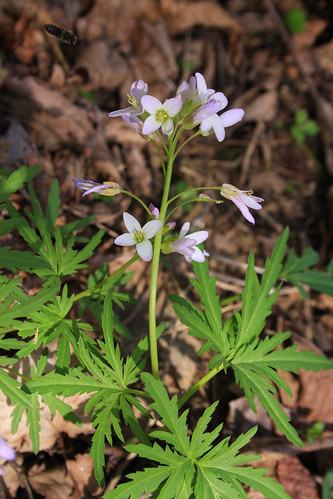
Edible Appalachian plant, cutleaf toothwort, Dentaria laciniata.
(*photo credit)
June 24, 2023 Eating in the Wild
On this feast of John the Baptist we recall that he lived on wild honey and grasshoppers. Yes, that is surprisingly good diet, since it supplies all the needed basic ingredients. Having once passed through the desert area that John inhabited, I admit that he was a brave and hearty soul. How could he have lived in such a forbidding place? By going wild all the way.
One of my great joys is eating something off the visited landscape. I will never forget visiting a major religious center and walking on its extensive grounds and finding virtually nothing to eat -- it was all affluent, ornamental and barren of the richness of wild plants worth tasting. How can we become acquainted with a place, if we have nothing to eat off the land for helping to gain a sense of place? The contrast between John's wilderness and ornamental "wilderness" is immense. But frankly reflecting more deeply, many modern folks would be more at home in the ornamental garden than in a wilderness with edible delights.
Caution! Not everything wild is edible and overdoing the wild routine could be dangerous to your health. I was warned by a guide in the desert of southern Israel after he saw me munching on the wild plants of central Judea; he advised me that "Here in the desert everything green is extremely poisonous and that is why it is still present. Animals know what to avoid but humans have a harder time." I did not do my grazing there.
A few years ago, a noted writer named Euell Gibbons (Stalking the Wild Asparagus) was a hearty fellow and considered the natural foods guru; his natural foods remarks were sponsored by Grapenuts cereal. However, his untimely death before sixty years of age was a blow to the wild natural foods movement. Several decades ago, we at ASPI had a volunteer who harvested all sorts of wild foods; one day he returned from his foraging and suddenly broke out with a rash over his entire body, but he couldn't decide, which of the samples caused difficulties.
Know your regional plants or at least ask someone expert for starters. Enjoy the greens of springtime: dandelion, poke shoots, violet leaves, plantain, lambs quarters, etc. and discover the mushrooms that are not poisonous -- an art I never fully mastered. Enjoy the blackcaps and blackberries and also the coming dewberries, blueberries, huckleberries, and later the elderberries. Taste the mayapples and fruits of the season: crabapples, wild plums, wild cherries (go lightly), papaws, and persimmons late in the year at the time for gathered nuts: hickory nuts of all sorts, black walnuts, acorns, and hazelnuts. We can always sample the wild foods, but it is best to have someone with the acquired experience to guide us. Much but not everything is to be enjoyed. Never take too much, unless you are sure. Moderation as always is best in the wild.
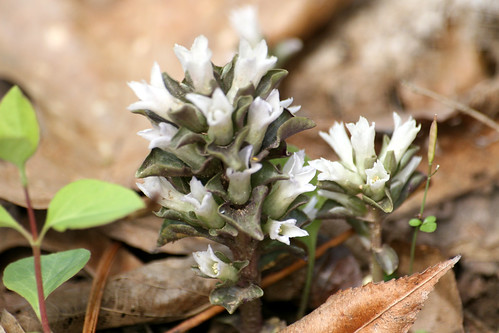
Pennywort, Obolaria virginiaca. Uncommon find in Casey Co., KY.
(*photo credit)
June 25, 2023 Dealing with Fear in the Modern World
Jesus says to fear no one (Matthew 10:26). Of course, we do have a fear of the Lord as a gift of the Holy Spirit. But at the same time that ought to be the extent of legitimate fear, for we are called to couple that fear of God with trust in a merciful and loving Lord. The peace Jesus calls his disciples to acquire was directed to their coming forth from behind locked doors and facing their persecutors. With adequate trust that the Lord will protect and take care, the disciples would be able to complete their mission. With the grace of Pentecost, the disciples no longer locked doors or expressed that fear of opponents; they became fearless and courageous in their undertakings – even when under threats from foes.
We believers in the future with Christ are challenged today, for we are immersed in a world with very real emerging or impending disasters. We have just endured a global pandemic with over five million who died; we live in a world of climate change with hot and wildfire-laden summers and lack of water in certain places and excessive floods elsewhere. Now those human fears of natural calamities are matched by rash and inhumane actions such as the war in the Ukraine and the presence of powerful nuclear weapons that could make the planet uninhabitable in a mere one-day exchange of hydrogen bombs.
Facing reality is an authentic spiritual exercise, but we are keenly aware that this is a challenge for many in today’s world. Large numbers are drawn to denial of the current situation or find an excuse to withdraw into themselves, or while knowing the situation prefer to escape into allurements. Over and over, we are called to express Christian courage that comes through the action of the Holy Spirit in our lives. Through trust in the Almighty we can both overcome our personal human fears and we can encourage our fearful neighbors to grow in trust as well.
Fear haunts many. Part of this fearful condition is expressed in an escapism that calls for consuming luxuries and doing so in ever greater degrees; the objects gained are simply not satisfying and causes the allured person to seek more and more. Wealth and escape go together and blind those who should be facing the reality of the current threats and taking collective action. Fear paralyzes them; it tempts the fearful to cling to the status quo, a condition in which many find more comfort. It is our task to shake these people to a reality where they must act responsibly and collaborate with others of good will.
Interestingly, this fearful situation is compounded by the inequality in our world, with materialists seeking to consume more and more unsatisfying resources and those impoverished hoping to become rich quickly. The fear of not having enough is countered by a living trust that God will give us the essentials needed for our salvation. This takes our own efforts and our trust in God.

Bearded Robber Fly, Asilidae sp., with prey.
(*photo credit)
June 26, 2023 Coping with Global Catastrophe
Why the title? Is it legitimate to leave our happy peace of soul and raise serious questions about the current condition of our threatened planet? We are torn between wanting to have peaceful trust in the Lord and at the same time, a sense of responsibility to do something to avoid catastrophe. Or should we say "Trust in God" and let it go at that? But on second thought, we know that trust is needed, but is not sufficient apart from our sense of responsibility to assist our neighbor.
Why discuss tomorrow's troubles? Doesn’t Jesus tell us that today's troubles are sufficient for the day? But what are some of today's troubles? Isn't current pollution today's concern? Do you think, as I do, that climate change is not tomorrow's problem but todays, and thus in prudence must be given consideration NOW? Do either you or I know how serious the consequences of not curbing greenhouse gases today are? When do we add to this impending disaster that of inequality of resources and the extravagant abuse by those with exotic un- or undertaxed wealth?
Are we responsible if we remain inactive? Must I (or we) be blamed for what a larger and uncontrolled group is doing to our world? Are we willing to say these associated issues are of our making and thus we have the responsibility to find practical solutions? Is social sin involved, and do we have responsibility as partakers to do something as part of our social responsibility? Is prayerful reparation a necessity? Is it that I am (we are) socially if not individually guilty? Is the mere announcement of an impending catastrophe a guarantee citizens of our Earth will react properly? Or will some, if not many of them, turn in fear to denial, excuse, or escape? If the allurements for the selfish majority hold sway, then will any prediction of disaster only lead the majority to the escape of eating, drinking and making merry?
What type of action is needed? Can this be addressed only to the elite, or to the rank-and-file citizenry? Must we seek to fight libertarianism with a form of social collectivism because influential consumers in an affluent society will lead us to group paralysis? Is this an individual or social solution and must it be fought on an economics and political level alone? Are there not prayer-related solutions involving recruiting all people of good will to work together, including the elderly, ill, or immobile?
Must we be responsibly mustering human resources to curb inequality and the breakdown of civilization? Is the toleration of under-taxed billionaires existing side by side to the very poor, who cannot meet essential needs, a disaster in itself? Is allowing inequality a social sin in itself? Must we find answers quickly to what is besetting our threatened planet – and do more than merely ask questions?
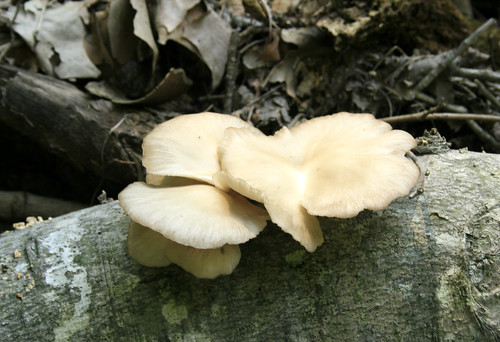
Newly-emerged fungi on fallen branches.
(*photo credit)
June 27, 2023 Reflecting While in a Stressed Forest
We all seek sacred places where we come closer to God. Often these are in the forests, especially in the summer months when the green foliage meets the blue of the heavens. It is harder to do more than pray for the recovery of damaged land, and still pristine areas that are not damaged or over-harvested are harder to find. Such places still exist, but maybe not near where our readers live -- and travel to distant places is not always the greenest practice. Really, our planet is hurting in all its parts, and being near to this is an opportunity to reflect deeply on the meaning of our life as those who help heal our Earth. Reflection in wounded areas involves a silent presence with all who suffer. Compassion opens us to the responsibility for undertaking remedial action.
Forests are perfect places where silence, except for the scurrying of wildlife, is taken for granted. We may have some knowledge of tree problems in the forest and take note of these in the moment we settle down for reflection. Unfortunately, today in our Appalachian region we have tree disease problems with hemlock, Fraser fir, elm, black oak, possibly white oak, ash, dogwood, white walnut, and on and on. The fact is that opportunistic assaults occur when the immune systems of a wide variety of trees are impaired. These systems are weakened by air pollution, and the inability of certain trees to withstand these assaults leads to weakening and possible death. When we go into a forest and recognize some of these stressed species, we feel a sense of threats of extinction to our fragile world. But that is not enough to keep us from spending time reflecting and meditating. In fact, it is a far more realistic situation than to seek an ideal "perfect" location, which may not exist.
Forests, even when hurting, are loveable to those close to nature. We glory in woodland sights, smells, and sounds among all the majestic and beautiful trees. See Appalachian Sensations: A Journey through the Seasons (Amazon.com). Listening in the woods brings out the voices of its inhabitants: sounds of crickets and bees, crows and other birds, and the rustling leaves and ground squirrels underneath. Many creatures talk to God and invite us into the conversation and we show gratitude. Forest smells are unique and allow our olfactory nerve to recall pleasurable experiences in the past -- our sacred memories. Taste of berries give us an additional flavor of the woods. In the past I make an annual retreat during wineberry and blackberry season in mid-July.
Our willingness to take off time and to go to the woods for refreshment and recommitment says something about us as pilgrims and about the forest as God's holy place worthy of being respected, protected, and affirmed. We need the company of plants and animals in what becomes for us sacred space. Our forest is an ideal place to venture forth from constructed settings to the more natural ones, and they are cool and colorful this time of year.
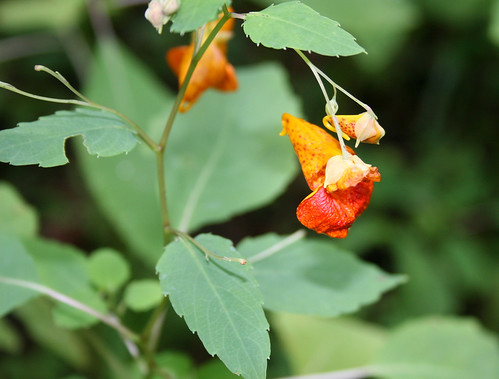
Spotted jewelweed, Impatiens capensis.
(*photo credit)
June 28, 2023 Prizing Jewelweed
A wild plant that flourishes in our Northern temperate region is “jewelweed” (Impatiens capensis), a member of the balsam family that manifests it relation to cultivated impatiens through beautiful flowers that bloom in mid-summer. Besides flowers, jewelweed is best known as a medicinal plant that can be used to soothe skin irritations of all sorts. Through a simple means of extraction with oil the benefits can extend to year-round use.
Jewelweed gets its name in either of two ways: dew or raindrops will bead on the leaf and look like a jewel in sunlight; or the flowers hang as jewels in a necklace from the plant. The plant is best known for its flowers, which can be pale yellow or, in the case of the spotted jewelweed, orange with red spots; the seed pod will split and spit out seed at a mere touch (thus the nickname, "Touch-me-not").
Many regard this annual plant as an invasive species and even caution against introducing it. Jewelweed grows best in shaded, wooded areas and could crowd out less aggressive species. Actually, it is easily removed where unwanted by pulling it out (root and all come easily) early in the summer before it gets too tall. However, I recommend its property of transpiring excess moisture; thus, the jewelweed is ideal for planting as surface for artificial wetlands where one must remove excess moisture through sponge-like vegetation. Here jewelweed holds a high place of favor.
Jewelweed is truly a healing plant, with 95% of users testifying to its beneficial results. The sap can be extracted and made into a tincture form by anyone. An emergency approach when outdoors in summer is to apply fresh jewelweed (bruised stalk or leaves) when poison ivy and oak accidentally touches skin. After a rash appears, you may still use jewelweed for soothing effects. Tales are told of people going into shock by being near poison ivy and being brought out of their condition almost immediately by the rapid application of jewelweed to the skin. In fact, jewelweed is known and used for a host of insect bites and cuts, bruises, warts, sprains, athlete's foot, and most fungal skin infections -- and just about any skin irritation. People who swear by jewelweed are hesitant to act as medical doctor and recommend it for all aches and pains; like all things, jewelweed has limited use. Fortunately, it is a well-known home remedy used by Natives and pioneers and easily distinguished by its characteristics.
A number of plants trigger a warm feeling when I find them present in wooded areas. Jewelweed is one. I always feel safe around a patch that is really soothing to behold as well as use. Jewelweed grows tall to about five or six feet and covers the area with shade. Certain insects and hummingbirds are drawn to the nectar, and mice and birds are attracted to the seeds. Regard jewelweed as a friend whose presence is worth celebrating.
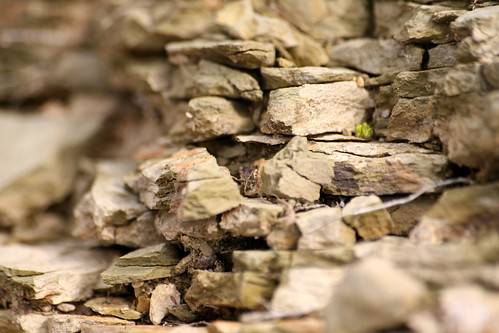
Weathered sandstone from Appalachian region of Kentucky.
(*photo credit)
June 29, 2023 Unchanging Rocks: Sts. Peter and Paul
You are Peter and on this rock I will build my Church. (Matthew 16:18)
The Apostle Simon Peter is to become a "rock" and yet neither Greek (Petros) nor Aramaic (the equivalent spoken language of Jesus) had this as a common name. It is something new to be called "rock," for generally that could mean an insensate being, a lifeless piece of materials. However, from Old Testament passages we speak of God as the rock of the ages and here rock has a sense of firmness and solidity, of security against a stormy sea and the rock foundation of a structure in contrast to building in sand.
Rock is the symbol of what is unchanging and not easily moved. If you go to "Little Round Top" at the Civil War's Gettysburg Pennsylvania battlefield, you see a photograph of a dead soldier sitting next to this large boulder. The astounding thing is that comparing the photographed features of 160 years ago and the rock today shows the same cracks and rough surface with extremely little change. Weathering, if any, is virtually undetectable. The same rock remains. I recall the sandstone cliffs (softer than the granite just described) overlooking the Rockcastle River Valley. It was a favorite resting place in warm weather surrounded by huckleberries and scented flowers, elevated enough to survey the meandering river below, and hear bird calls. I would sit and examine rock surfaces and find a microcosm of activity: ants and other little critters amid a living surface of lichens and mini-forests. Rocks weather, but are more suddenly changed by a rare earthquake.
St. Peter becomes a firm institution as well as a living person. Over the centuries the successors were people of a wide variety and yet the office has stood firm, giving us the confidence that the Lord is always with us during these ages. Rocks signify this promise and commitment to be a person who covenants with believers. Peter recognizes Paul's talents, and we celebrate both today in this feast, for Peter was leader and Paul the preacher, showing together the complementarity of divine gifts in loving cooperation; God's pledges to remain with us.
Like all creatures, organic and inorganic, rocks can teach us. They are firm and yet subject to movement by greater forces; they are apparently unchanging. but still weathering gradually; they are warm in summer's sun, but cold in winter's frigid climate; they seem lifeless yet on closer examination support life. Rocks go beyond the apparent: they teach us to look further for the characteristics that we yearn to possess: firmness of purpose, eternity in life, ever-present warmth. Rocks serve as pointers to deeper mysteries for, even in silence, they speak, if only we are willing to spend some time in observation and reflection. Rocks indicate people like Peter and Paul, the foundation of leadership authority and the living word.
I Miss Kentucky
By Al Fritsch, SJ
I miss Kentucky. These three words can mean so many different things, with various nuances. The first way involves our whole heart and soul, in that we really and truly do miss the great, beautiful state of Kentucky after 47 years of living and working there. I can say without too much sentimentality, that I was born there and it was my home for a long period of time. Again, there are different ways of looking at how we express our absence from a place we love. We can say I miss Kentucky on a hot July day when the humidity is overwhelming, and we miss that particular humidity, but would not necessarily want it back. So when we say miss we mean that our accustomed feeling of home is absent and our body can sense the difference. At the same time, we miss the people who made Kentucky home, and the unique culture and lovely landscapes with farm animals and singing birds all summer, the scavengers and wildlife scampering around, and the smell of the seasons. And in my case all the Masses and memorial services that were held over time are things I truly miss when thinking of Kentucky – the Bluegrass State.
Looking a little deeper at this from a pastoral ministry viewpoint, even though I miss the state after working there for so long and have good memories of it, it is impossible for me to go back and continue that work. I’ve reached a part of my life that is now over and time has moved on. It’s not coming back no matter how much I wish it would. It’s gone, and yet it feels so present, and the good times, the smell of fried chicken, the coming storm, the people and the places, all these can flood back upon us. But they are what they are. They’ve come and they’re gone. And very soon, they become part of our stories.
Let us remember that there are many people whose lives are rather short, certainly shorter than mine has been. And these people make the best of what they have been given. Is it right then, for us to miss what life we have been given? The answer for me as a Jesuit, whose calling may involve traveling all over the world, is that it’s part of our task to accept what comes. A call to do this or that. And that brings us into the question of home. We do stop in places and after a while become familiar with them and settled, creating our lives. However, it’s not perfect. This world is exactly what Saint Paul says, our homeland is not here. We are pilgrim people. We are people who are on the way to greater glory, and that means we have not yet arrived where we’re going. We all are on our way, not just a few - it’s everyone. Those who put too much emphasis on home, forgetting the future ahead of us, are not doing the most perfect thing either. But we are called to see the simple fact that there is something up ahead, not missed because it hasn’t been formed, hasn’t yet been created. We help to make this future, and we are asked by the Lord to do this. Therefore, these things from our past, which give us great encouragement, these parts of our experience then become a stepping stone to who we will become.
We are called to do something even greater. And that greatness can, if we look at it a certain way, include something miraculous in our future. Our spirituality can grow and deepen as we age, and we may see that what we missed was only the precursor to a new life. Change is what is appropriate for this transition. So when we say we miss what’s past, let’s do it with a minimum of bitter-sweetness, also knowing there is something more to think about. I like to look at it both ways. I think it’s important for us not to be buried in our past, looking backwards and liable to stumble and fall, but rather to look towards the future and the mystery up ahead. We’ve still got a lot of things to do. Yes, we miss Kentucky, but at the same time, we learned from Kentucky how to move on.
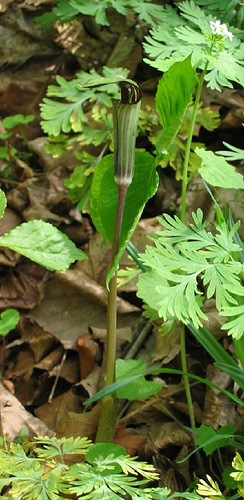
Jack-in-the-pilpit, native Appalachian plant.
(*photo credit)
June 30, 2023 Promoting Appalachia
A favorite of my publications is Appalachian Sensations: A Journey through the Seasons, with photos of Appalachia by prize-winning photographer Warren Brunner. Copies are easily available from several sources including Amazon.com. Warren insisted that the compendium of texts and photos, along with Scriptural quotes, be totally positive in tone and express the sights, sounds, tastes, smells, and touching sensations of the region. Too many emphasize the negative aspects of a region with social troubles, and they fail to see that enduring qualities showing positive aspects are healthy and worth celebrating.
Constantly we are confronted with negative stereotypes of our richly endowed region -- and they are hard to answer. In 1990 at the dedication of the National Cathedral's environmental facade, Prince Philip, Queen Elizabeth's husband, asked me, "Do they still have stills in Appalachia?" My answer was "a few, but they are quite rare." What I didn't say to him was that moonshining is not nearly as lucrative for the folks here as is growing marijuana, and so the economy has shifted from one illegality to another. Negative stereotypes deserve positive accounting:
Music and dance of mountain folks, whether indigenous or later arrivals are treasured and shown in social gatherings. Appalachian crafts and arts are quite varied and include woodworking, corn shuck dolls, patchquilts, pottery, and other art forms, many of them primitive art of an authentic creative style and depth. Often the crafter has much time in winter to develop skills and finish art work to sell during the festival season.
* Storytelling is an accomplished art in areas where the oral tradition has been strong. Appalachian stories can be most imaginative and entertaining and are featured at important events. Love of land and extended families in given locations and communities is quite strong. Many folks who leave for work elsewhere will return faithfully year after year because of the deep attachment for the place of origin and its people.
* Hospitality is one of the major assets of the region. People show this to strangers, with a willingness to assist those who are in trouble. One of the most erroneous misconceptions about mountain people is that they are hostile to outsiders. That is simply not the case.
* Scenery is still one of the region's greatest assets. See our Eco-tourism in Appalachia. The region has incredible scenic resources such as rivers and valleys, mountains, lakes, rock formations, and wildlife areas. Native plants and animals are Appalachian treasures. They include abundant wildlife, numerous wildflowers, a hundred types of native trees and over 200 resident or migratory birds. The Mixed Mesophythic Forest is the world's oldest and most varied temperate hardwood forest – a treasure!

